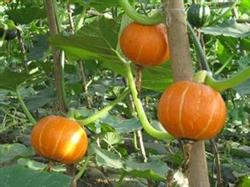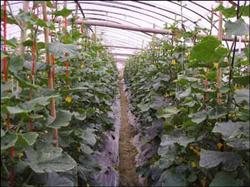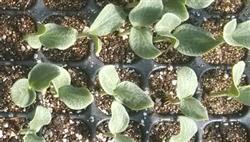Cultivation techniques of Western Pumpkin in Spring greenhouse

Pumpkin is a kind of nutritious and healthy vegetable, while the western pumpkin imported from abroad has less water content, more solids, more non-reducing sugar and starch, more starch / whole sugar ratio, less crude fiber and high crude protein content. therefore, the taste and taste are good, and the quality is much better than that of domestic pumpkins. Since 1999, our institute has successively introduced seven new pumpkin varieties from Taiwan Nongyou seed Company and Thailand Zhengda Group seed Company for trial planting, all of which show the characteristics of early maturity, high yield, labor-saving and cost-saving, high economic benefits and so on. The fresh fruit production of 40 mu organized in Huangnong Village, Lixin Township, Lishui City in the spring of 2001, the yield per mu was above 1000kg, among which Xu Jinfu agricultural yield was 0.8mu, and the average yield per mu reached 1950kg. In the same year, our institute planted in the greenhouse, with an average yield of 2325kg per mu. The spring cultivation techniques of western pumpkin are introduced as follows: 1. At present, there are many varieties of western pumpkin. According to the results of comparative test of varieties introduced by our institute, "Dongsheng" and "Yipin" selected by Taiwan Nongyou seed Co., Ltd.; Thailand Zhengda Group Jiangsu Zhengda seed Co., Ltd. selected "orange red" series and "Lubao", the comprehensive character performance is better. The fruit color of the above varieties is mainly divided into two types: golden red and dark green, and the corresponding varieties can be selected according to the market demand. 2. Cultivation techniques (1) the sowing period of western pumpkin is suitable for cool climate and is not heat-resistant (susceptible to virus disease in high temperature period). The whole growth period of greenhouse planting in spring is generally about 115 days, 65 days from emergence to flowering, and 40-50 days from fruit to harvest. The experimental results, combined with our meteorological data, show that the optimum sowing time for spring planting in greenhouse in Lishui Plain is from late December to early January. (2) preparation of seedling raising shed and nursery bed in ① seedling raising shed: seedlings are raised in double-layer greenhouse and small arch shed. The preparation of the seedbed: generally, the greenhouse with a width of 7m is divided into four rows, the width of the seedbed is 1.2m, of which the width of the furrow is 0.7m. First of all, the ground in the shed is leveled, a geosyncline with a width of 1.2m and a depth of 0.30m is dug out, and the trough is covered with straw with 15cm thickness. After covering the soil, the electric hot line is covered with soil and then covered with plastic film. The preparation of ② nutritious soil: 3 parts of paddy soil, 1 part of coke ash and proper amount of calcium magnesium phosphate fertilizer were fully mixed. Soil water content is required to be about 70%. Determination method: grasp the nutritious soil by hand and clasp it into a ball, and it is appropriate to let go of the landing and spread out naturally. 10cm × 10cm plastic bowl nutrient soil row was placed behind the seedbed and sprayed with 500x carbendazim to be sown. ③ seed soaking to promote germination: Western pumpkin seeds have been disinfected before sale, so there is no need to disinfect again. Soak the seeds in clean water for one day, drain the water, wrap them in a wet cloth and put them in a constant temperature of 30-32 ℃ for about 2 days, and then sow the seeds when they are white. ④ sowing: in the installed nutrition bowl, punch a small hole with tweezers, put the seed radicle (tip) down, tweezers small hole, one for each bowl. After sowing, the seeds were covered with charred plaster about 1cm, and sprayed with 800x methyl topiramate. Finally, a plastic film was covered on the nutrition bowl, and then a small arch shed was built. ⑤ seedling management: plastic film was removed 3-5 days after sowing. The temperature management principle of high before and low after raising seedlings in spring is adopted. From sowing to seeding, the temperature in the greenhouse should be controlled at about 25 ℃, if the temperature at night is lower than 15 ℃, the temperature should be heated in time, and the temperature should be controlled at about 20 ℃ from the true leaf to the three-leaf stage, and the temperature should be cooled and refined 10 days before transplanting. There is generally no need to apply fertilizer at seedling stage. The management of water is very important. It is better to dry than wet. Watering should be carried out in sunny days, and choose around 11:00 noon as well, rainy days and cold air should never be watered. No matter it is cloudy, rainy or sunny, the shed should be opened for ventilation, the rainy day is at 1-2 noon; the sunny day is generally opened at 9 am, and the shed is covered before 4 pm. At seedling stage, attention should also be paid to the prevention and control of sudden fall disease and blight disease. The seedling age is 30-35 days. (3) planting ① for soil preparation: vertical planting in greenhouse and plastic film. The width of the greenhouse is mostly 7-8m, divided into 4 beds, the width of the border is 1.Om, the width of the groove is 0.8m. ② base fertilizer: the main fertilizer is base fertilizer, accounting for about 60%. In the middle of the border, 40 piculs of fertilizer, ammonium bicarbonate 50kg were applied in the middle of the border, the soil was leveled, and 1.2 m wide plastic film was covered for planting. ③ transplantation: before planting, the seedling bed was sprayed with 600x chlorothalonil, and the disease-free strong seedlings were selected for transplantation. The plant spacing is about 0.5m and the row spacing is 0.7m. Single-row zigzag transplantation was used. Generally, 700 trees are planted per mu. After planting, live trees are watered and small arched sheds are built on them. (4) Management after planting ① topdressing and ventilation to keep warm: topdressing was carried out 3-4 days after transplanting and at the beginning of climbing. After planting, because of the low temperature, it is mainly heat preservation, but ventilation is still necessary. The specific operation requirements refer to the seedling shed. ② pruning: pumpkin grows strongly, generally using three-vine pruning method, that is, two lateral vines are left in one main vine, and other extra lateral vines and sub-vines that grow again should be knocked out in time. ③ artificial pollination and fruit setting: cultivated in early spring, male flowers are later than female flowers, and less male flowers should be artificially pollinated, that is, some pollen should be glued to the male flowers and coated on the female flower stigma with a brush. The fruit of western pumpkin is very good, each node can grow a female flower. In general, the female flowers within the 70cm of the root base should be removed, leaving one fruit on each side of the vine and two fruits on the main vine. Let the melon bear in the part other than 70cm, it is beneficial to the formation of big melon: ④ re-apply fruit expansion fertilizer: when the fruit develops to the size of egg, the compound fertilizer 20Kg/ mu is applied in the hole away from the base of the seedling 25cm. (5) about 1 month after pollination, the melon color can be exploited and listed when the color changes from light yellow to orange red. At this time, the market price is better, but the quality is not the best. The old melon should be harvested (about 50 days) when the melon color is dark, and the harvest should generally be carried out in the morning on a sunny day, leaving melon stalks about 2cm.
- Prev

Cultivation techniques of western pumpkin in greenhouse in spring
1. At present, there are many varieties of western pumpkin. According to the results of comparative test of varieties introduced by our institute, "Dongsheng" and "Yipin" selected by Taiwan Nongyou seed Company, "orange red" series and "Lubao & quot..." selected by Jiangsu Zhengda seed Co., Ltd., Zhengda Group of Thailand.
- Next

Cultivation techniques of early ripening Japanese Pumpkin in Spring
Japanese pumpkin, also known as western pumpkin, is a new type of vegetable pumpkin introduced from Japan, South Korea and other places as a high-quality pumpkin in recent years. This kind of pumpkin has compact and fine meat, sticky or powdery, excellent flavor and small fruit shape. When harvested as a vegetable, its single melon weighs 1 kg.
Related
- Where is it suitable to grow horseradish in China? it is expected to see the middle altitude horseradish in Alishan.
- How to prevent tomato virus disease reasonably? (Control methods included)
- Many people like to plant towel gourd on the balcony. What are the main points of this method and management?
- What crops can chili peppers be mixed with?
- Fertilization techniques and matters needing attention in Tomato
- What are the grafting techniques for peach seedlings in spring?
- Harm and control methods of root swelling disease of Chinese cabbage
- What are the pests of sweet potatoes? How to prevent and cure it?
- Symptoms, causes and Control methods of navel Rot in Tomato
- The cause of "Cucumber rotten bibcock" in Farmers' planting Cucumber and its Control Plan

